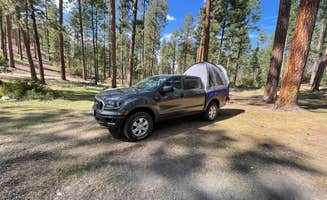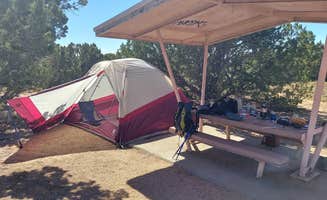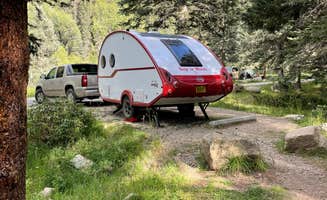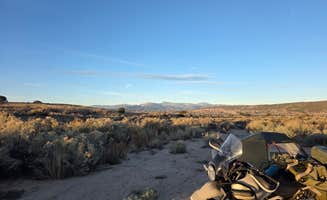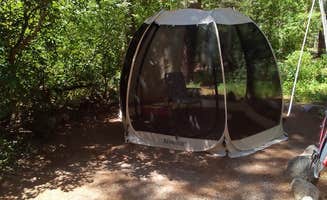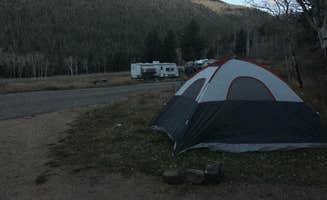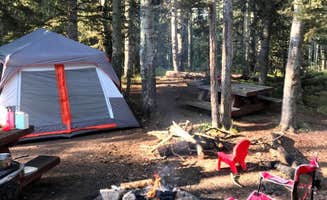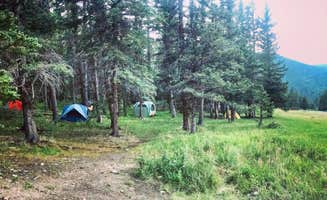Dispersed camping sites near Truchas, New Mexico provide access to mountain terrain in the Carson National Forest at elevations between 8,000-9,000 feet. Several primitive camping areas exist along forest roads in this region, offering cooler temperatures than lower elevations even during July and August. Winter camping remains challenging due to snow accumulation and limited road access from November through April.
What to do
Hiking to mountain lakes: Agua Piedra Campground offers direct trail access to higher elevation destinations. "There is a trail head with 2 trails, one atv accessible and one hiking/horse that goes up to Indian Lake. Beautiful views and about 1200' elevation change," notes Tammy V. These trails typically remain accessible from late May through early October.
Creek exploration: Children can safely play in the shallow mountain streams at several campgrounds in the area. "We went exploring in the river next to the campground and then took a short hike up the river to some amazing river canyon views," shares Donaji R. from Santa Barbara Campground. These waterways run highest during spring snowmelt in May and early June.
Winter activities: Big Tesuque Campground remains accessible during winter months despite its 10,000-foot elevation. "Road is paved all the way and regularly plowed during the cold seasons. I'm sure this is very busy during the warm seasons but we had the place to ourselves during the week in early December," writes Jorge G. Cross-country skiing and snowshoeing routes connect to nearby trail systems.
What campers like
Mountain stream sounds: Most campsites near flowing water receive positive reviews for their natural ambiance. "All sites are close enough to the river to hear it from a tent. The site has drinking water and pit toilets, but no cell service. Overall, stay was very peaceful and relaxing," Jacqueline D. comments about Santa Barbara Campground.
Fall colors: The aspen groves surrounding Truchas camping areas provide spectacular autumn displays. "Beautiful spot for fall camping since the leaves are changing colors and temperatures are cooler," reports Megan E. about Hyde Memorial State Park. The color peak typically occurs between late September and mid-October depending on elevation.
Privacy between sites: Agua Piedra Campground receives praise for site layout. "Some campsites were more separated and others were close together if you were with a group. River runs along the camp for fishing, and they were catching fish," mentions Tammy V. The diverse site configurations accommodate both group and solitary campers.
What you should know
Limited connectivity: Cell service remains inconsistent throughout the region. "No cell/wifi service. BUT what it does have is quiet, and peacefulness, and charm, and views views views. It is just what WE want when we go camping," explains Robin T. about Agua Piedra Campground. For internet access, some travelers visit nearby communities.
Water availability varies: Not all campgrounds maintain reliable water sources year-round. "Water was not available. Very peaceful and quiet with lots of great views," notes Julie F. about her May stay at Agua Piedra. Campers should bring adequate water supplies regardless of posted amenities.
Seasonal wildlife: Borrego Mesa Campground visitors encounter both domestic and wild animals. "Campground is on ranch land (keep an eye out for cows)," warns Katherine C. Yellow jackets become particularly active at this location during late summer, according to Mac M., who observed "a good number of yellow jackets around" during their stay.
Tips for camping with families
Playground access: Black Canyon Campground offers built play structures not commonly found at more primitive sites. "There is also a nice playground for those traveling with little ones who may need to burn some steam," mentions Deacon J. This feature proves valuable during extended stays.
Kid-friendly hiking: Trails with minimal elevation gain work best for younger children. "The trail is phenomenal. The incline is quite steep, but the loop is a reasonable length and I've seen families with young children and elderly folks successfully complete the loop," reports Luke M. about Black Canyon. Most sites have at least one trail suitable for beginners.
Weather preparation: Mountain conditions change rapidly regardless of season. "Chilly, even in July, just FYI, come prepared," warns C.J. L. about Big Tesuque Campground. Temperature drops of 30°F between day and night occur regularly, making layered clothing essential for family comfort.
Tips from RVers
Site access challenges: Overlook Campground provides magnificent views but requires careful driving. "Dirt road leading up to campground was totally drivable but heavily washboarded at the beginning, so be advised if you're towing," cautions PJ M. The campground accommodates up to 25-foot travel trailers, though larger rigs can access certain sites.
Limited hookups: Truchas-area camping prioritizes primitive experiences over amenities. "No water, power, or dump station, but there are individual garbage containers at each site," explains PJ M. about Overlook Campground. RV campers typically need to travel 20+ miles to find full-service dump stations.
Elevation considerations: Higher elevation camping sites near Truchas affect RV systems and comfort. "Submersed in the forest. Some sites weren't level, so if you're in a RTT or RV, be sure to have plenty of leveling tools," advises Cheryl M. about Black Canyon, adding "If you aren't used to elevation, the camp sits up 8400 feet, it'll take a bit more time to do normal activities."


